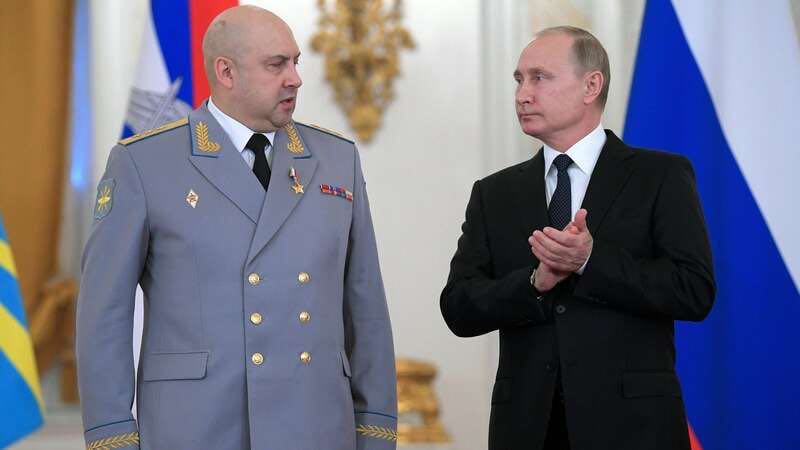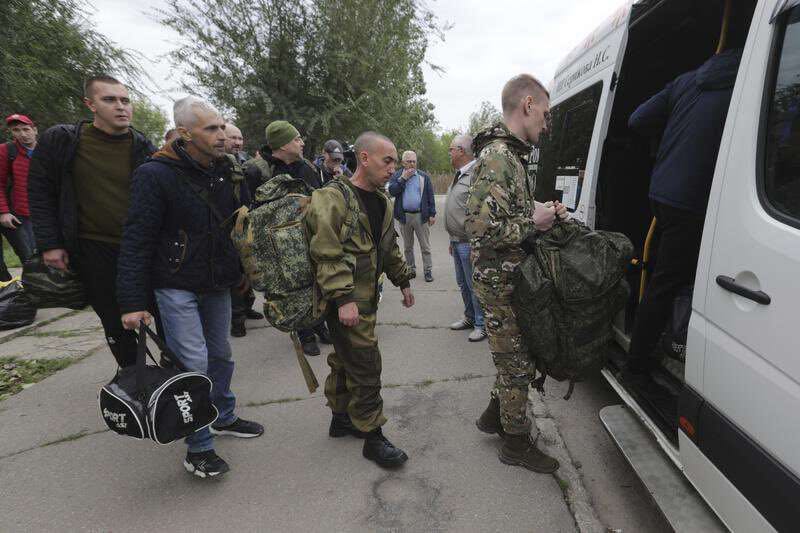The image of a highly competent authoritarian leader is the modern dictator’s most powerful governance tool. However, the idea of a capable dictator is now in jeopardy. The administration is dysfunctioning and the mobilization changed the mood of the Russian population. But it is too early to jump to the conclusion, that Putin's rule is fatally wounded, argues political analyst Kirill Rogov in a commentary for the Wilson Center.
 Putin with the new commander of the invasion army, general Surovikin. Photo Kremlin
Putin with the new commander of the invasion army, general Surovikin. Photo Kremlin
by Kirill Rogov
Perhaps never in his twenty-three years as president has Vladimir Putin found himself in such a tight spot as he has today. More than losses in the war against Ukraine, the crumbling of his administration’s well-oiled machinery and leaks in the information bubble have put him on the back foot, unable to claim success with any credibility. The parallels with the late Soviet era are unmissable—but neither do they mean he will not, in the end, find his way to a resolution he can claim as success.
President Putin has been in losing situations before. Two prominent examples are the 2002 hostage crisis in the Dubrovka Theater in Moscow and the 2004 school siege in the North Ossetian town of Beslan, which saw many children among the killed and wounded. Putin refused to negotiate with the terrorists and so failed to prevent numerous hostage casualties.
In each of those cases, however, he managed to deflect blows to his reputation through propaganda and asymmetric escalation. After the terrorist attack in Beslan, in which 333 people were killed, Putin canceled gubernatorial elections in Russia, presenting this decision as a counterterrorism measure. Such asymmetric responses helped him fortify his image as a strong-willed leader who, despite temporary setbacks, knows what to do.
Putin’s arrogance and incompetence
Today’s situation is sharply different, primarily because Vladimir Putin is not on the receiving end of a challenge but is himself the initiator of operations that lead to defeat. The partial mobilization he announced at the end of September marked the transition to a third tactic in his war against Ukraine.
The first tactic, a 'blitzkrieg of intimidation,' was defeated during the early weeks of the war. Putin misjudged the Ukrainian army’s and Ukrainian society’s ability to resist. The outcome was the destruction of Russian advance units marching, they thought, to hold a military parade in Kyiv.
Putin is himself the initiator of operations that lead to defeat
The second tactic, an 'unrelenting offensive,' replacing the blitzkrieg, was effectively a transition to a full-scale war of attrition. Using its overwhelming advantage in firepower, the Russian army focused on executing a systematic advance deep into Ukrainian territory in southern and southeastern Ukraine. During the summer this tactic, too, stalled.
As a result of the West’s intensified arms deliveries to Ukraine and the Russian military’s unpreparedness for a protracted war, Russia soon lost much of its advantage in firepower, along with significant force losses. Although Putin was apparently warned about these outcomes, he did not act promptly. The result was a successful counteroffensive by Ukrainian forces and the collapse of the front line in northeastern Ukraine.
Both operational defeats appear to be the result of Putin’s arrogance and incompetence. This is an important point. As Daniel Treisman and Sergei Guriev correctly note in their book, Spin Dictators: The Changing Face of Tyranny in the 21st Century, the image of a highly competent authoritarian leader is the modern dictator’s most powerful governance tool.
The idea of a capable dictator is now in jeopardy
This image allows modern autocrats to manipulate not only the electoral majority but also the professionals called to serve the regime. However, this approach works only as long as the leader’s counterintuitive decisions, often taken against expert advice, prove to be at least partially successful or can be presented to the public as such. During the war against Ukraine the failures of unprofessional planning have been all too evident. As a result, the idea of a capable dictator is now in jeopardy.
The third tactic of Putin’s war, adopted at the end of September, was designed to present the 'special military operation' as a 'people's war' under the slogan 'The motherland is in danger.' However, it too turned out to be an administrative fiasco from the very beginning.
The Russian army’s recruitment objective was to assemble a combat-ready force of between 100,000 and 150,000. However, the very objective—the order to hastily acquire a sufficient number of mobilized soldiers at any cost—put the entire 35 million citizens potentially liable for military service at risk of mobilization. Eager to report results, regional authorities and military committees grabbed everyone they could get their hands on. As a result, the conscription of more than 200,000 people within two weeks turned into a logistical disaster.
 Russian mobilized recruits. Photo from twitter
Russian mobilized recruits. Photo from twitter
Putin’s 'partial mobilization' increased the number of servicemen in Russia by almost a third. However, no infrastructure has been prepared to outfit, house, feed, or organize this new army.
As a result, the mobilization campaign is reminiscent of the administrative practices typical of the late Soviet era, when the inefficient and opportunistic government, failing to achieve its announced goals, would discredit those goals in the eyes of the public.
Failing political machine
This situation and the nature of the recent administrative campaigns are not characteristic of Putin’s managerial style. While lacking true efficacy, his administrative machine has been set up for a rather convincing imitation of efficacy, which supports an impression of the government’s competence and ability to achieve its goals and enforce its decisions.
Previously, this machine did not tolerate blatant managerial incompetence and severely punished those exhibiting it, believing this behavior devalued the leader’s political capital. In this case, however, both the machine itself and its informational support have failed. Officials’ comments on the war in Ukraine contradict each other and actions on the ground contradict all the commentary, creating an impression of chaos.
Putin’s officials have been similarly ham-fisted in executing other parts of the new plan, primarily in hastily devising the legal grounds needed for the illegal annexation of the partly occupied regions of Ukraine.
The presidential administration’s domestic policy arm is a well-oiled political machine that plans the nation’s electoral campaigns and applies the approved spin. For several months, this department reportedly had been working hard to determine how and when to stage 'referendums' intended to give the annexation a veneer of legitimacy.
The dates of the referendums were rescheduled multiple times. Teams of campaign managers would travel to the occupied territories, only to be recalled to Moscow. In the end, they were given only a week’s notice to organize the referendums, without any concern for credibility. The old mechanism, however cynical, was broken here as well.
The parallels with the late Soviet period are not accidental
The dysfunction of Russia’s current administration is a serious and dangerous sign. First, it indicates a breakdown in management and communication between policymakers and those responsible for implementing policy. Second, it indicates an uptick in opportunism among officials. The parallels with the late Soviet period are not accidental. Quiet sabotage and opportunism permeated the Soviet administrative machine, fueled by total distrust of the top political leadership and the perception that it was incompetent and lacked capacity to execute on any of its plans.
The cascading failures in the early months of the war have tarnished the image of Putin as a leader who succeeds (or at least gets away with failure), as a leader who, after losing one square, is able to seize two other squares, to the enemy’s surprise. As the Russian political commentator Tatyana Stanovaya has astutely noted, the Russian elites today, accustomed to Putin’s side being the winning side, are faced with a new reality. They are now forced to choose between various defeat narratives instead of just habitually sticking to the winning side.
No-win trap
It is too early to jump to conclusions. Putin’s tenacity used to allow him to try different approaches to an issue until he found one that allowed him to appear successful in the eyes of an outside observer. Opinion polls show that the mobilization came as a shock to the public, dramatically changing the mood. However, poll respondents do not yet indicate a majority opinion about the events or negative emotions focused in one direction or another. In this sense, the judgment that Putin's political machine has finally broken down is premature.
Putin's information machine has not been able to shield the population from the hard truth
It is also a fact that for eight months, Putin has been unable to escape from the no-win trap, and his information machine has not been able to shield the population from the hard truth. Polls conducted at the end of September showed that the Russian public is highly aware of the failures on the Ukrainian front: 77 percent of those surveyed said they had followed the Ukrainian army’s counteroffensive. Meanwhile, official information channels have sought to obscure the defeat. This means that the average citizen, though inside the propaganda bubble, is well aware of what is happening outside it. This informational doublethink may well lead to a collapse of trust in official channels of information at the next turn of events, just as happened in the late Soviet era. But to claim that this has already happened is also premature.
The question of whether this informational and managerial breakdown is fatal or whether Putin’s political machine can still be fixed will be the subtext to all the events of the coming weeks and months.
This article was originally pubished by the Wilson Center
